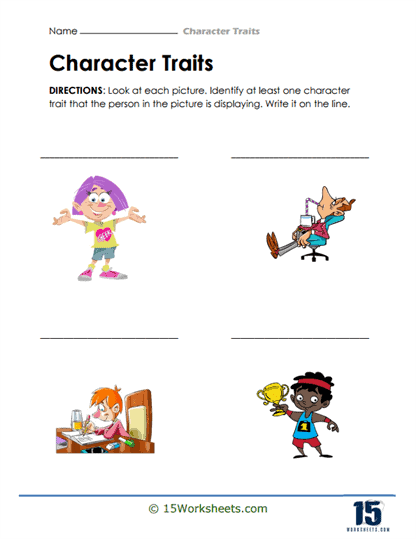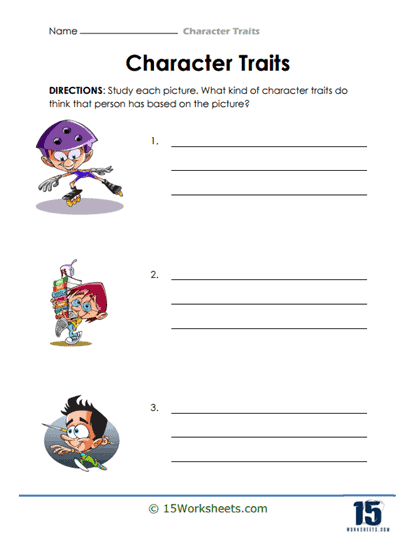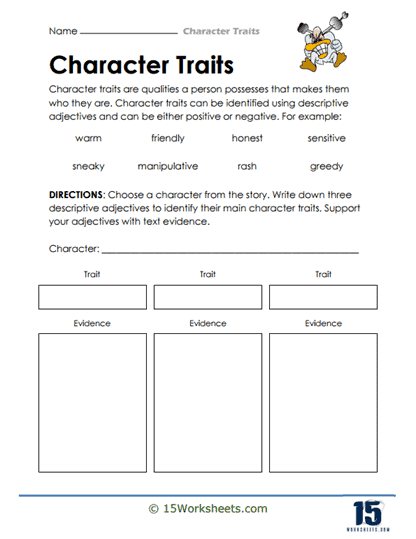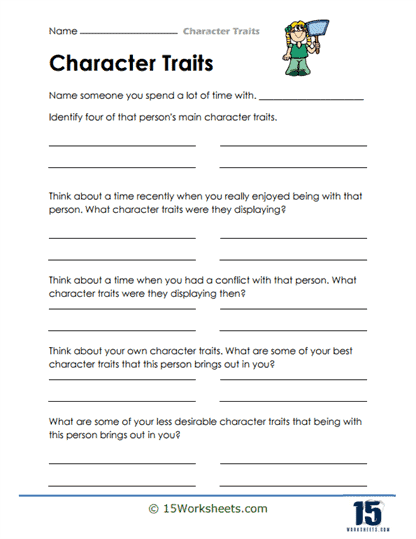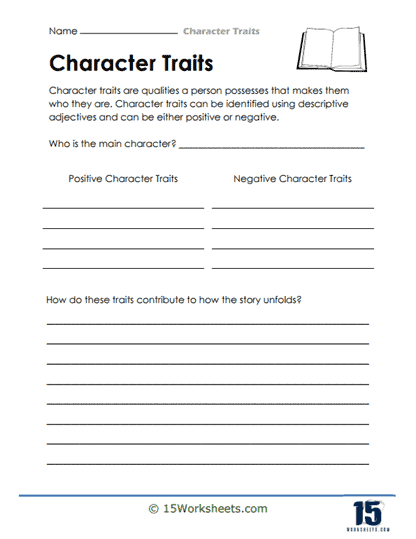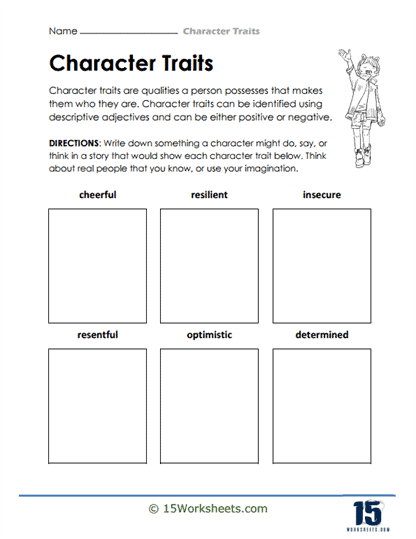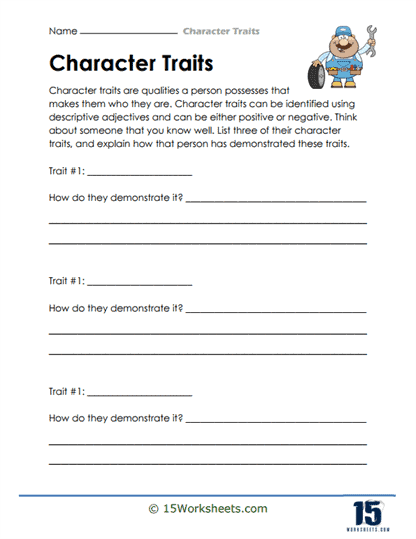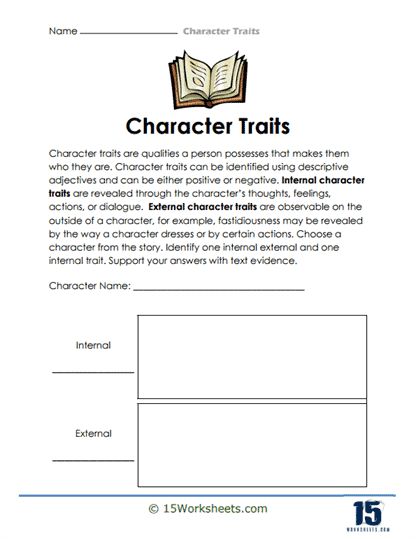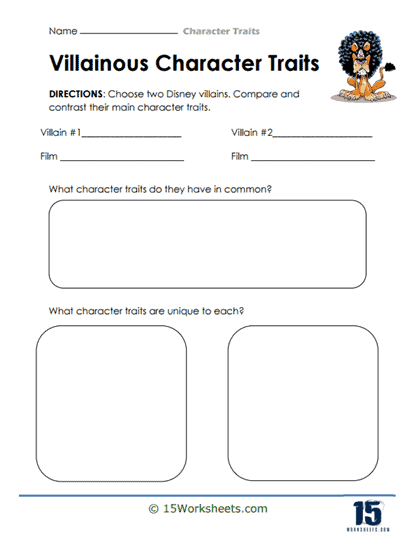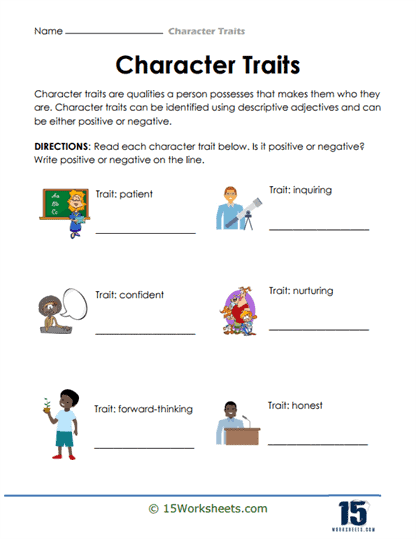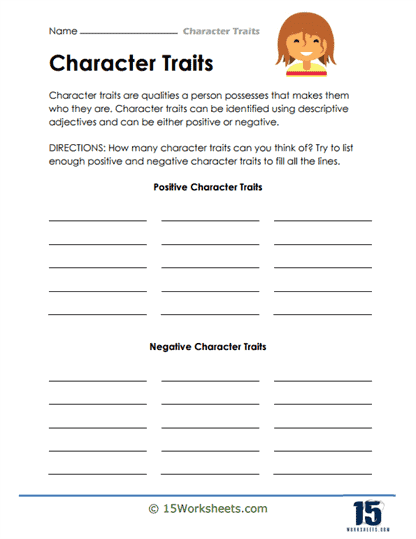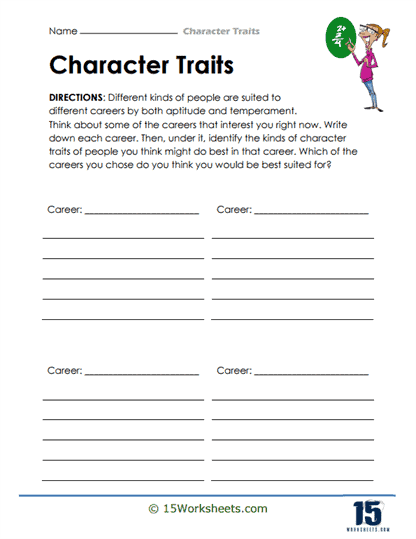Character Traits Worksheets
All About These 15 Worksheets
So, let’s think about one of your favorite characters from a book, movie, or video game. It might be Harry Potter from the Harry Potter series, Katniss Everdeen from the Hunger Games, or maybe even Mario from the Super Mario games. What makes these characters interesting? It’s not just the things they do, but also the way they think, react, and behave. These are known as their character traits.
Character traits are the qualities or characteristics that define a person or a fictional character. For example, Harry Potter is brave, Katniss Everdeen is resourceful, and Mario is adventurous. Sometimes, the traits are very obvious, like Harry’s bravery when he battles Voldemort. Other times, they are more subtle, like Katniss’s resourcefulness when she figures out how to survive in the Hunger Games.
Now, imagine if you had to create a new character for a story you’re writing, or if you had to analyze a character from a book you’re reading for school. You’d need to think about what that character is like – what their personality is, how they respond to challenges, what they love or hate, and so on. This is where Character Traits Worksheets come into play.
Character trait worksheets are designed to help you think about, analyze, and describe characters. They often have different sections that guide you in describing a character’s traits. For example, there might be a section where you list out the character’s physical attributes, like their hair color, age, or height. Then there could be a section where you write about the character’s personality traits, like whether they’re shy or outgoing, kind, or mean.
These worksheets also have parts where you can give examples of how the character shows these traits. For instance, if you’re describing Harry Potter’s bravery, you might mention how he chose to fight Voldemort even though he was afraid. Sometimes, they might also include sections for a character’s motivations (what they want or what drives them), their feelings (how they typically feel or react emotionally), and their relationships (how they interact with other characters).
These worksheets can help you dive deeper into understanding a character. They guide you in thinking about a character in a more detailed and structured way. They’re like a map, guiding you through the different parts of a character’s personality. Plus, they can make writing or analyzing characters way more fun because they help you see characters in a new, deeper way!
What Are Character Traits?
Character traits are the core elements that define who a person is, whether in real life or within the pages of a story. These qualities, attributes, and characteristics shape not only a character’s outward actions but also their inner world-their thoughts, feelings, motivations, and how they respond to the events around them. The traits that define a character are not mere labels; they are the building blocks of personality, shaping how a character interacts with their environment, other characters, and the challenges they face. A well-crafted character doesn’t just react to situations in a static or predictable way. Instead, their distinct traits drive their decision-making, forging a path that feels authentic and engaging to the audience.
Character traits serve as the threads that weave together the personality tapestry of a character. Whether these traits are noble or flawed, they are what make characters come alive in readers’ minds. For example, a character who is consistently brave might inspire admiration and serve as a role model, while one prone to dishonesty might evoke frustration or even sympathy, depending on the context of their behavior. Both positive and negative traits add depth to a character, making them more nuanced and multi-dimensional. Readers connect more deeply with characters when they see their flaws and virtues unfold in response to the story’s conflict and challenges. These traits, positive or negative, often serve to mirror the complexities of human nature, allowing readers to relate, empathize, and even wrestle with the character’s decisions and growth.
Character traits not only shape individual characters but also drive the story forward. A character’s personality often dictates the course of the plot, influencing key moments and how tension is resolved. Consider, for example, a protagonist whose unwavering sense of justice propels them into difficult situations, or an antagonist whose greed leads them down a path of moral decay. Without clearly defined traits, characters can feel flat or unmemorable, reducing the impact of their journey. In contrast, strong character traits create characters that stay with readers long after the story ends, as their struggles, transformations, and achievements resonate on a deeply emotional level.
How To Identify Character Traits in a Story
Identifying character traits in a story is a crucial skill for anyone trying to understand the deeper layers of storytelling. Traits can be uncovered through various facets of the narrative, each providing clues to the character’s underlying personality and motivations. By carefully observing a character’s actions, speech, thoughts, and interactions with others, readers can piece together a portrait of who that character truly is beneath the surface.
Actions
A character’s actions are often the most direct way to discern their personality. What a character chooses to do-especially in high-stakes situations-reveals their priorities, strengths, and weaknesses. For instance, a character who consistently puts others’ needs ahead of their own might be seen as compassionate or selfless, while one who manipulates others for personal gain may come across as deceitful or ambitious. Actions serve as windows into a character’s moral compass, and they are rarely random in a well-constructed narrative. Pay attention to moments of decision or crisis, where characters must act swiftly. These moments often strip away pretense, allowing their true character to shine through. How they respond under pressure-whether with bravery, cowardice, or indifference-often reveals their deepest traits.
Dialogue
The words a character speaks can be just as revealing as their actions. Through dialogue, characters express their thoughts, beliefs, and attitudes, which in turn reflect their traits. It’s not just what they say that matters, but how they say it. The tone, choice of words, and even the rhythm of their speech can suggest traits like intelligence, humor, insecurity, or arrogance. Consider a character who speaks in short, clipped sentences, always getting to the point. This character might come across as decisive, perhaps even cold. In contrast, a character who rambles or uses elaborate language may reveal a trait of nervousness, overconfidence, or even intellectualism. Dialogue also allows characters to reveal their values and intentions, often in subtle or indirect ways. Listening closely to how characters talk to others-whether with kindness, sarcasm, or cruelty-can provide a rich insight into their personality.
Thoughts and Feelings
For stories told from a character’s perspective or those that dive into their inner thoughts, these internal reflections can be a goldmine for uncovering character traits. A character’s private thoughts often reveal insecurities, hopes, fears, and desires that may not be apparent in their outward behavior. For example, a character who presents themselves as confident and assured might secretly wrestle with self-doubt, revealing a more complex inner world. Inner thoughts offer the most unfiltered view of a character’s mind, making it easier to discern deeper motivations and emotional vulnerabilities. This inner dialogue allows readers to connect with the character on a more intimate level, understanding why they act the way they do, even when their external behavior might suggest otherwise.
Reactions
How a character reacts to the events and challenges in the story can also reveal key traits. Characters faced with adversity or difficult decisions often show their true selves in these moments. A character who responds to setbacks with resilience demonstrates strength, while one who reacts with anger or frustration might reveal impatience or a lack of control. These moments of reaction are often pivotal because they show whether a character’s outward persona matches their inner traits. Some characters may surprise readers by reacting in ways that challenge earlier perceptions, adding complexity to their characterization.
Relationships
A character’s relationships with others can be one of the most telling indicators of their traits. How they treat the people around them-whether friends, family, or enemies-provides valuable insights into their values, loyalties, and moral compass. A character who goes out of their way to protect and support loved ones may reveal traits of loyalty and care, while one who manipulates others for their own gain might be seen as selfish or cunning. Relationships also expose a character’s ability to empathize, cooperate, or lead. The dynamics between characters, particularly how they change over time, can reveal a great deal about individual traits and how they evolve throughout the story.
Appearance
While physical appearance may not always directly indicate character traits, it can still provide subtle clues. A character who is meticulously well-groomed might be seen as image-conscious or detail-oriented, while someone who appears disheveled or unkempt could be signaling a disregard for societal norms or a chaotic personality. Though appearance should never be the sole basis for identifying traits, it can offer a surface-level insight that, when combined with other factors, helps build a fuller understanding of the character.
Author’s Descriptions
Direct descriptions from the author, or observations made by other characters, can provide a straightforward way to identify traits. These descriptions might highlight a character’s dominant traits, whether through the author’s narration or through how other characters perceive and describe them. While these descriptions are valuable, they should be balanced with the other methods of observation-such as actions and dialogue-so as not to take them at face value without evidence.
Character Development
Perhaps the most satisfying way to uncover character traits is by watching how a character grows and evolves throughout a story. Characters are rarely static, and their development-whether positive or negative-reveals much about their core traits. A character who overcomes their flaws, learns new skills, or deepens their relationships with others is demonstrating traits like adaptability, growth, and resilience. On the other hand, a character who becomes more cynical or hardened by their experiences may reveal a growing sense of disillusionment or bitterness. This progression in traits adds a dynamic layer to character analysis and enhances the reader’s connection to the story’s emotional and thematic arcs.
Why It Matters
Understanding character traits is not just about labeling a character as “brave” or “selfish”; it’s about peeling back the layers of personality to understand how these traits interact with the story’s broader themes and conflicts. By identifying and analyzing character traits, readers gain a deeper appreciation for the nuances of a story and the intentions behind the author’s choices. Patterns in a character’s actions, dialogue, and relationships can reveal recurring themes, offering a richer, more thoughtful engagement with the narrative. Recognizing these traits enhances not only the reader’s connection to the characters but also their ability to interpret the broader messages within the story.



